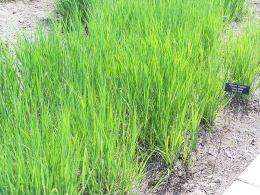October 11, 2011 weblog
Mutant maize genes increase viability of switch grass for biofuel

(PhysOrg.com) -- A new study published in the Proceedings of the National Academy of Sciences reveals how the use of mutant maize genes inserted into switch grass may increase their biofuel viability.
The research, led by George Chuck from the University of California and the U.S. Agriculture Department, along with the Joint BioEnergy Institute have discovered by that inserting the CG1 (Corngrass1) Corn gene into switch grass (Panicum virgatum) they are able to triple the amount of starch that is stored in the stem of the plant. This increased amount of starch makes the conversion into sugars needed for biofuel much easier.
Switch grasses grow on prairie terrain and make it a crop that will not compete with land needed for food crops such as corn. The new altered switch grass does not flower so the risk of genetically modified plant variants being spread is limited. Continued research is needed to determine if the modification will make the grasses more susceptible to predators.
This discovery could eventually be applied to other plants in order to increase their viability as potential biofuel crops.
More information: Overexpression of the maize Corngrass1 microRNA prevents flowering, improves digestibility, and increases starch content of switchgrass, PNAS, Published online before print October 10, 2011, doi:10.1073/pnas.1113971108
Abstract
Biofuels developed from biomass crops have the potential to supply a significant portion of our transportation fuel needs. To achieve this potential, however, it will be necessary to develop improved plant germplasm specifically tailored to serve as energy crops. Liquid transportation fuel can be created from the sugars locked inside plant cell walls. Unfortunately, these sugars are inherently resistant to hydrolytic release because they are contained in polysaccharides embedded in lignin. Overcoming this obstacle is a major objective toward developing sustainable bioenergy crop plants. The maize Corngrass1 (Cg1) gene encodes a microRNA that promotes juvenile cell wall identities and morphology. To test the hypothesis that juvenile biomass has superior qualities as a potential biofuel feedstock, the Cg1 gene was transferred into several other plants, including the bioenergy crop Panicum virgatum (switchgrass). Such plants were found to have up to 250% more starch, resulting in higher glucose release from saccharification assays with or without biomass pretreatment. In addition, a complete inhibition of flowering was observed in both greenhouse and field grown plants. These results point to the potential utility of this approach, both for the domestication of new biofuel crops, and for the limitation of transgene flow into native plant species.
© 2011 PhysOrg.com



















